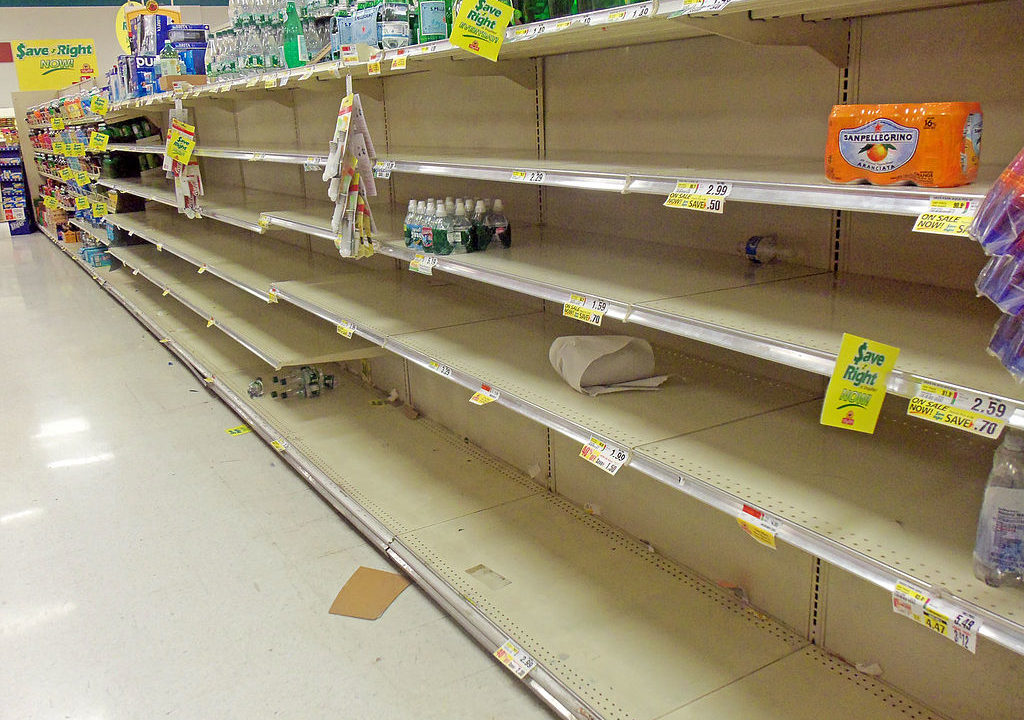Will California’s Gov. Newsom End Food Assistance for Undocumented Immigrants?
A year after the state crafted the first ever food assistance program for undocumented immigrants, the 2023 budget puts it on hold. Wikimedia Commons
Wikimedia Commons
Inflation bore down hard on Californians in 2022, but the effect was especially toxic at the lower reaches of the income scale. By last fall, two out of three households in the state earning less than $35,000 were struggling to pay for basic necessities like food, rent and health needs. Perhaps more surprising, nearly half of those in the $35,000 to $74,999 bracket also reported being in that same boat.
The state’s attempts to address its growing housing crisis may ultimately make life easier for lower income Californians, although that is a long, slow turn. Gov. Gavin Newsom’s planned expansion of Medi-Cal to essentially remove immigration-related barriers, meanwhile, will bring the state closer to offering at least some form of health care to almost all of its residents.
But food insecurity persists, despite the presence of state and federal programs to provide assistance. And the worst of it is visited upon California’s undocumented residents.
The Golden State is home to some 11 million immigrants, about 2.3 million of whom are undocumented. Overwhelmingly, Californians have a positive view of immigrant workers, and in a 2021 survey conducted by the Public Policy Institute of California, 87% of adults polled said there should be a way for undocumented immigrants to remain in the country legally.
For decades, though, undocumented workers have strained to afford life in the state, and it often comes down to not having enough food for themselves or their families. In a four-year California Health Interview Survey from 2017 to 2020, 45% of undocumented immigrants said they were affected by food insecurity, and the figure for those age 17 or younger was 64%.
For decades, undocumented workers have strained to afford life in California, and it often comes down to not having enough food for themselves or their families.
The ensuing years of COVID and inflation have only intensified the need for action. “With rising prices, decades of exclusion from some food assistance programs and the ongoing wage disparities for undocumented workers, what we are hearing today is quite profound,” said Benyamin Chao, a health and public benefits policy analyst at the California Immigrant Policy Center. “The urgency is now.”
Given all that, a seemingly small wrinkle in Newsom’s proposed 2023-24 budget actually looms quite large.
In last year’s budget, Newsom proposed and the Legislature approved a measure that would allow income-eligible Californians over age 55 to receive food assistance (commonly known as food stamps) regardless of their immigration status. It would set up the first program of its kind in the nation, with some benefits beginning as soon as later this year—if its funding held up.
It did not—or at least not in the initial version of the new budget. Newsom’s 2023-24 proposal pushes off even the first stage of implementing the plan until 2027. In so doing, the state saves a little money now (about $35 million to help prepare for the program) and more later (an expected $113 million by 2025-26). Those costs are mostly tied to updating the state’s automated systems that distribute the benefits.
In a $223.6 billion budget, such a savings isn’t terribly head-turning. But the proposal attempts to address a projected $22.5 billion revenue shortfall in part by deferring spending on certain projects that had been authorized in previous budgets. The food assistance program for older undocumented Californians falls into that category.
“Safety net supports are critical in helping Californians meet basic needs,” said Sara Kimberlin, a senior policy fellow at the California Budget and Policy Center. “The poverty rate would be dramatically higher without them.”
The governor has not specifically addressed his proposal to delay the program.
Neither California state nor federal food assistance has ever been available to undocumented immigrants, and the backstory gets complicated. In 1996, the U.S. Congress passed a welfare reform bill that denied federally funded assistance to legal permanent residents, such as green-card holders, until they’d resided in the country for five years. But it gave states the right to fund their own program for such immigrants, and California lawmakers quickly established the California Food Assistance Program (separate from Cal Fresh, the state’s version of the federal Supplemental Nutrition Assistance Program, or SNAP).
CFAP has since been used to bridge the food gap for some immigrants, providing an average of $165 a month to about 35,000 legal permanent residents. But it, too, has had no provision for undocumented residents. Newsom’s budget last year sought to change that — and just as the governor has done with Medi-Cal, he chose to phase in this expansion one age group at a time, beginning with those over 55.
That decision baffled some who lobby on behalf of immigrant workers, who wondered if CFAP could be more effective by addressing the food insecurity issues in the youngest age group first. “We need to be able to cover a whole family unit,” Betzabel Estudillo, a senior advocate with Oakland-based Nourish California, told Cal Matters at the time.
Absent the expansion of the California Food Assistance Program, pressure to meet undocumented immigrants’ food needs will revert to an already burdened system of local and regional food banks.
Now, though, even the older undocumented immigrants will wait years for the program to begin. And not only does that delay tend to push the program into “out of sight, out of mind” territory, it also runs out the clock on many of those older residents whom Newsom’s 2022 proposal was meant to benefit.
“It sounds a little dark, but this is an aging population, with an increasing number of ailments and medical issues,” Chao said. “It’s odd that we’re making them wait years longer to even begin accessing food assistance. These are investments in our state’s overall health.”
The statistics bear out that last point with authority. According to the nonpartisan Center on Budget and Policy Priorities, “A substantial body of research links SNAP, the nation’s most important anti-hunger program, with lower health care costs and improved health outcomes.” Advocates say the effect is profoundly felt among children, for whom lack of adequate nutrition leads to poorer health and school performance.
Absent the expansion of CFAP, pressure to meet undocumented immigrants’ food needs will revert to an already burdened system of local and regional food banks. In a statement released after Newsom announced his 2023-24 budget proposal, the California Association of Food Banks said it was “disappointed” in the governor’s decision to delay implementation of the program “and that (the plan) does not include expansion to all ages.”
Newsom’s administration had the right idea last year: get as many Californians out of food insecurity as possible, regardless of their immigration status. As the Cal Budget Center’s Kimberlin puts it, one way for the state to support those struggling to keep up with basic expenses is by “protecting these programs from cuts or delays [and] ending exclusions that block access to these basic supports.”
It is a piecemeal process, but a critical one. As of today, it’s also on hold.
Your support is crucial…With an uncertain future and a new administration casting doubt on press freedoms, the danger is clear: The truth is at risk.
Now is the time to give. Your tax-deductible support allows us to dig deeper, delivering fearless investigative reporting and analysis that exposes what’s really happening — without compromise.
Stand with our courageous journalists. Donate today to protect a free press, uphold democracy and unearth untold stories.






You need to be a supporter to comment.
There are currently no responses to this article.
Be the first to respond.